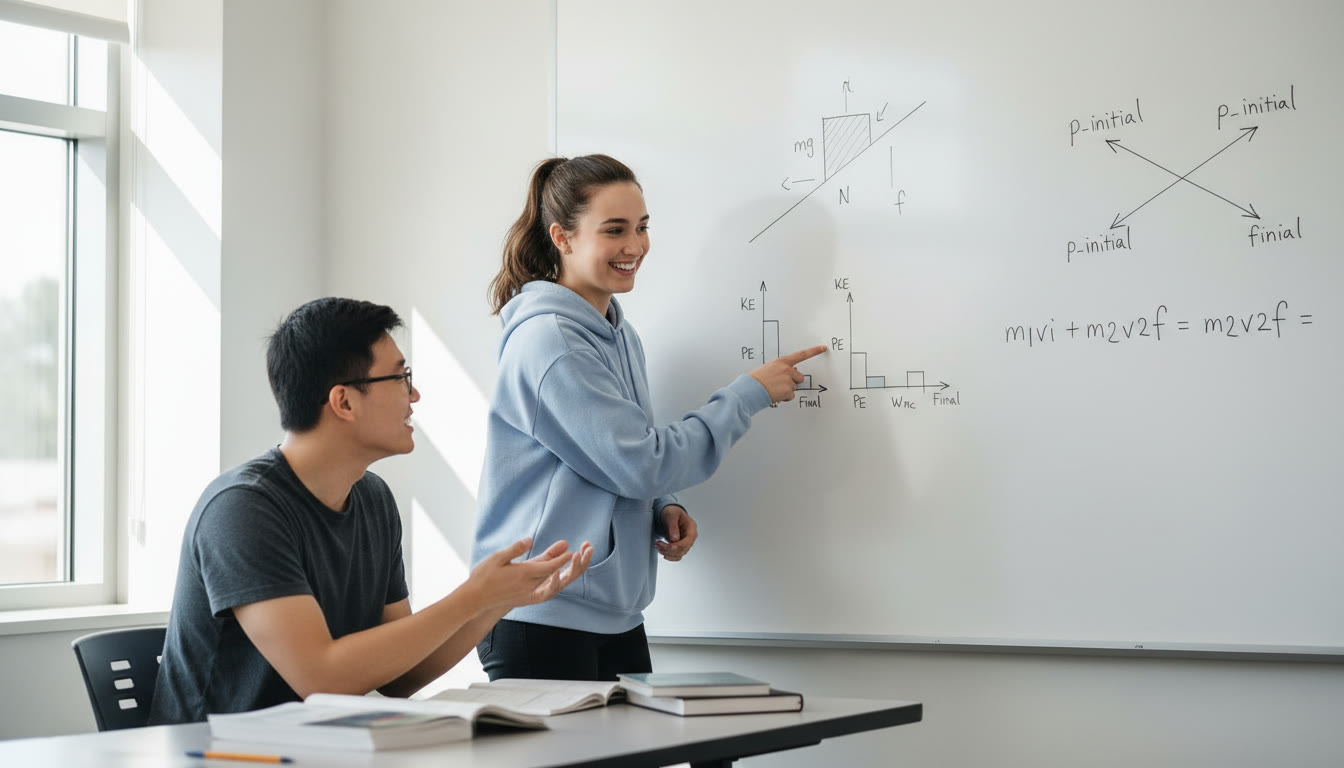Introduction: Why Work, Energy, and Momentum FRQs Matter
If you’re prepping for AP Physics C: Mechanics, you’ve probably noticed a pattern — questions that test work, energy, and momentum keep showing up on the free-response section. These topics aren’t just abstract formulas you memorize; they’re tools for understanding how objects move, collide, and exchange energy in the real world. The best part? Once you learn a set of clean, repeatable strategies, many FRQs feel predictable and solvable rather than intimidating.

Big-picture strategy before you write anything
Start with a five-minute ritual each time you open an FRQ:
- Read the entire problem once, uninterrupted — don’t try to solve on your first pass.
- Identify the physical system (single particle, block on incline, two-body collision) and whether energy and/or momentum are conserved.
- Sketch — even a rough one — and annotate known quantities and directions of motion. A tiny sketch earns points and clarifies signs.
- List what the problem asks for in plain words (find speed, work done by friction, impulse, etc.).
- Pick your primary principle(s): energy methods, impulse-momentum, work-energy theorem, or Newton’s laws where necessary.
Why this works: FRQs reward clarity and correct choice of principle. A focused start reduces algebraic wandering and prevents time loss.
Core concepts you must have intuitive and procedural grasp of
1. Work-Energy Theorem
Statement: The net work done on an object equals the change in its kinetic energy (W_net = ΔK). Practically, this is golden when forces vary or when you can avoid integrating forces by using energy methods.
2. Conservation of Mechanical Energy
When non-conservative forces (like friction) don’t act, mechanical energy (potential + kinetic) is conserved: E_initial = E_final. If friction or inelastic collisions act, quantify energy loss by including work done by non-conservative forces.
3. Impulse-Momentum Theorem & Momentum Conservation
Impulse equals change in momentum (J = Δp). In isolated systems (no external horizontal forces), momentum is conserved. Use momentum conservation to solve collision problems or to relate velocities before and after interactions.
4. Work by a Force = ∫F·dr
For variable forces, set up the integral. But often AP FRQs give potential energy functions or allow energy shortcuts so you don’t need messy integrals—recognize when to integrate and when to use energy relationships instead.
Step-by-step recipe for typical Work/Energy FRQs
Below is a practical, repeatable recipe you can follow under timed conditions. Treat it like a checklist.
- Step 1 — Translate: Convert the prompt into a sketch and a list of givens/unknowns with units.
- Step 2 — Choose the tool: Decide between energy (global picture) and Newton’s laws (local forces). Energy often reduces algebra.
- Step 3 — Sign convention: Pick an orientation for positive/negative and stick with it — annotate velocities and displacements.
- Step 4 — Conservation check: Identify which quantities are conserved (mechanical energy? momentum?) and where non-conservative work appears.
- Step 5 — Algebra carefully: Keep symbolic work as long as possible. Replace symbols with numbers at the end to avoid rounding errors.
- Step 6 — Units and plausibility: Do a quick units check and a reality check (is the speed reasonable? is energy negative when it shouldn’t be?).
- Step 7 — Box your answer: Clearly label final numeric values and their units. If multiple parts build on each other, reference earlier answers when appropriate.
Common FRQ scaffolds and how to attack them
Scenario A: Block sliding on surface with friction — find speed or stopping distance
Often the problem gives mass m, coefficient of kinetic friction μ_k, incline angle θ, or a frictional force. Use energy with non-conservative work or apply W_net = ΔK plus W_friction = -f_k·d.
Recipe:
- Write ΔK + ΔU = W_nonconservative. If object starts from rest and ends at speed v, then 1/2 m v^2 + U_final – U_initial = -f_k d.
- Express f_k: f_k = μ_k N. On an incline, N = mg cosθ; on horizontal, N = mg.
- Solve algebraically for the unknown (v or d). Keep m symbolic until the end — it often cancels.
Scenario B: Spring launch or roller-coaster style energy exchange
These encourage potential energy bookkeeping: elastic potential, gravitational potential, kinetic energy. Track energy conversions and losses if given.
- Write 1/2 k x^2 + m g h + 1/2 m v^2 and set initial and final energies equal if no non-conservative forces act.
- If friction exists, subtract W_friction = f_k d from the initial energy before equating.
Scenario C: Collisions and momentum with energy questions
AP loves combining momentum conservation with energy bookkeeping: e.g., find velocities with momentum, then compute kinetic energies to see how much energy was lost.
- Use momentum conservation for velocities: m1 v1 + m2 v2 = m1 v1′ + m2 v2′.
- Compute initial and final kinetic energies separately to find ΔK; that gives energy lost to inelastic processes.
- If asked about impulse or average force, use J = Δp and F_avg = J/Δt when time is provided.
Table: Quick reference — Which method to choose
| Problem Feature | Primary Method | Why |
|---|---|---|
| Variable force over distance | Work integral or energy method | Directly accounts for force variation; energy can avoid integration if potential is given |
| Elastic spring involved | Energy conservation with elastic potential | 1/2 k x^2 is simple to include; avoids Newton’s laws unless asked for force |
| Collision (no external horizontal forces) | Momentum conservation | Momentum is vector conserved; use energy only to find energy loss |
| Friction or non-conservative forces | Work by non-conservative forces + energy bookkeeping | W_nc = ΔE_mech captures energy lost as heat |
| Short impulse over tiny time (e.g., collision) | Impulse-momentum theorem | Directly relates force-time area to Δp; avoids needing acceleration profile |
Algebraic and sign traps — what examiners penalize most
Here are recurring pitfalls that cost points and how to avoid them:
- Sign errors: Define axis and stick with it. For energy, remember that potential energy depends on chosen zero; kinetic energy is always positive.
- Forgetting vector nature of momentum: Treat directions carefully. A negative velocity is not a mistake if your sign convention supports it.
- Dropping mass prematurely: Mass cancels in many energy equations, but not always — check before canceling.
- Confusing work and energy: Work is a process (force acting over displacement); energy is a state function. Use them appropriately in phrases like “work done by friction” vs “energy dissipated.”
- Rounding too early: Keep symbolic forms until the final step to avoid cumulative rounding errors.
Sample walkthrough: A typical multi-part FRQ
Let’s walk through an example structure (not an actual College Board problem, but AP-like). Suppose a block of mass m slides from rest a distance d down a 30° incline with kinetic friction μ_k. Part (a) asks for speed at bottom. Part (b) asks for the work done by friction. Part (c) asks how much impulse would be required to stop the block in time Δt horizontally after it leaves a curved track.
Step-by-step solution outline
- Sketch the incline, label h = d sin30°.
- Energy approach: Initial energy = m g h; final = 1/2 m v^2 + work lost to friction. So m g h – f_k d = 1/2 m v^2.
- Compute f_k = μ_k m g cos30°.
- Solve for v: v = sqrt(2 (g h – μ_k g cos30° d)). Keep g symbolic if needed.
- Work by friction = -f_k d (answer with sign and units). If they want magnitude, state positive value and explain negative sign indicates energy removal.
- For stopping impulse horizontally: J = Δp = m (0 – v_x). If velocity leaving track has horizontal component v_x, use J = -m v_x and F_avg = J / Δt if asked.
Notice: Most of the heavy lifting came from a clear choice to use energy methods and careful sign handling.
Time management on test day
The AP Physics C FRQ section rewards clarity more than flash. You’ll often have 90 minutes for multiple FRQs — pace yourself.
- Spend 2–3 minutes reading each problem thoroughly and outlining the plan.
- Allocate your time proportional to the point value of the parts; don’t spend 20 minutes on a two-point algebra step.
- If you’re stuck on an algebraic manipulation, write down the physics reasoning and move to the next part — partial credit is common for correct approach.
- Always circle or box final numerical answers with units.
Practice habits that translate to higher scores
Practice deliberately and with reflection:
- After each practice FRQ, write a short note: what strategy worked and where you lost time.
- Mix problem types: a week with collisions only, a week with springs and non-conservative forces, then mixed sets.
- Time yourself in realistic blocks and replicate exam conditions occasionally to train endurance.
- Study solutions from official College Board rubrics to understand how points are awarded — they value clear reasoning and correct application more than perfect algebra.

How targeted tutoring can speed your progress
Working with an expert can compress months of independent practice into weeks: targeted feedback helps you fix recurring mistakes (like sign errors or poor symbolic manipulation) and gives you custom practice problems that address your weak spots. For students who want a blend of human guidance and intelligent insights, Sparkl’s personalized tutoring offers 1-on-1 guidance, tailored study plans, expert tutors, and AI-driven insights that highlight the exact types of FRQs you should practice next. When your time is limited, that personalization directs effort where it matters most.
Checklist for answering energy/momentum FRQ parts (copyable for last-minute review)
- Sketch and label directions and axes.
- List givens and unknowns with units.
- State explicitly which quantities are conserved.
- Write the governing equation(s) symbolically first.
- Perform algebra; substitute numbers last.
- Do units and reasonableness check.
- Box your final answer and include units and sign explanation if relevant.
Final tips and mindset for exam day
Keep calm and stay methodical. Confidence in Physics C comes from repeated, focused practice and from developing a set of dependable tools you reach for automatically. Remember that the graders are looking for correct use of physical principles and clear reasoning. Even if you can’t finish every algebraic step under time pressure, a clear statement like “momentum is conserved, so m1 v1 + m2 v2 = m1 v1′ + m2 v2′” along with a partial solution can earn substantial credit.
Finally, don’t underestimate the psychological benefits of structure: a clean sketch, labeled axes, and a one-line statement of which theorem you’re using will not only earn points, it will steady your thinking in the moment.
Closing — Make your practice intentional
Physics C FRQs on work, energy, and momentum reward thoughtful, principled approaches. Practice with intention: focus on the why, not just the how. Build the habit of choosing the simplest valid method first, keep your work structured and symbolic as long as possible, and use resources that adapt to your weaknesses. If you pair that with occasional targeted tutoring — for example, Sparkl’s personalized 1-on-1 support and tailored study plans — you’ll find that problems that once felt random become patterns you recognize and conquer.
Start your next study session with one FRQ: spend 10 minutes planning the approach before you write anything. You’ll be surprised how much more efficient and accurate you become — and that efficiency is the difference between a good score and a great one.
Good luck — you’ve got this. Keep practicing smart, and let the physics do the heavy lifting.

















No Comments
Leave a comment Cancel